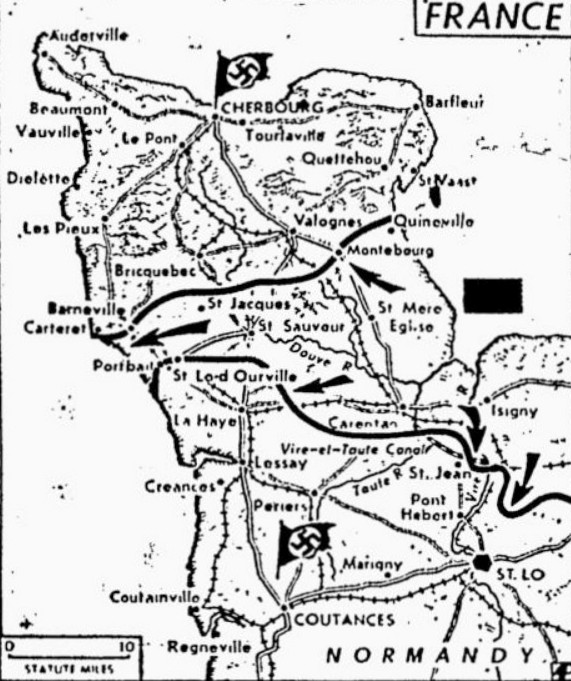Einer Gegen sechs Stahlkolosse –
Hitler-Jugend in der Bewährung
pk. Über der Küste der Normandie wogten die grauen Wolkenpakete eines trüben Junitages. Seit die Landungsboote von der britischen Insel herüberkamen und die Flugzeuge mit den Kokarden des Feindes Truppen absetzten, mischte sich auch der Rauch von Brand und Explosionen in den windgetriebenen Wirbel des tiefen Himmels. Das Lärmen von Granaten mit Abschuß und Einschlag, die von hüben und drüben ohne Sparsamkeit versandt wurden, war in der Luft und schwellte auch in den Stunden der kurzen Frühsommernächte nicht ab.
Zwei junge Grenadiere von der SS-Panzerdivision „Hitler-Jugend“ saßen irgendwo im Raum von Caen im selbstgegrabenen Deckungsloch. „Ihr habt hier gegen feindliche Panzer zu sichern,“ hatte der Sturmführer gesagt, der selbst die Einweisung vornahm. „Vor uns müssen welche stecken, also seid auf der Hut.“
Seitdem begrenzte die Welt der beiden, achtzehnjährig der eine und drei Monate älter der andere, eine jenseitige Hecke. Daß es dahinter noch etwas gab, Wiesen, Gebüsche und ebensolche Hecken, war ihnen klar, und das Poltern der Granaten aus Geschützen und Werfern, das Bersten der Bomben und das Morsen der Maschinengewehre verrieten es ja auch deutlich genug. Aber für die beiden Soldaten waren die Hecke vor ihnen und der Weg, der am Panzerdeckungsloch vorbei dorthin führte, jetzt die einzige Geographie. Man mußte in diesem Bezirk höllisch aufpassen und sich tarnen, weil es das Leben galt.
Minuten, vielleicht aber auch Stunden saßen die beiden Jungen im Erdloch. Zwischendurch schielten sie mal zu einem Luftkampf hinauf, der sich mit milchigen Kondensstreifen in den mittlerweile aufgeklärten Himmel grub. Aber die Hecke gegenüber blieb natürlich unter Kontrolle. Vögel, die der Schlachtenlärm immer wieder aufscheuchte, huschten dort aufgeregt ein und aus. Sonst aber blieb es ruhig, bis…
Ja, bis sich die Zweige auseinanderbogen und die Stirn eines gewaltigen britischen Panzers daraus hervorlugte.
Was sich nun im Deckungsloch der beiden jungen Soldaten ereignete, war das eigentlich Heroische, mehr vielleicht, als die Tat selbst, die sich anschloss.
Wie es drüben in der Hecke raschelte, flüsterte der eine: „Still jetzt, sie kommen. Siehst du, dort steht einer.“
Der Kamerad hatte ihn längst schon erspäht. – „Ich werde ihn anspringen.“ – „Nein, lass es mich tun.“ – „Du nicht, du kannst das nicht so und…,“ er suchte nach einer Begründung, „und dann musst du auch an deine Mutti denken.“ – Wirklich: er sagte „Mutti,“ der Junge.
Sie geschah in jenen Sekunden, diese hastige Zwiesprache, die sonst dem Schreck Vorbehalten sind. Nicht Ehrgeiz und erst recht keine Angst waren es, an denen Rede und Gegenrede sich entzündeten. Nur Fürsorge, das Einstehen für den Kameraden, regierten den Augenblick.
„Los jetzt. Schieß, so viel du kannst, aber schieß nicht auf mich.“
Der eine stieß sich den Kolben des Maschinengewehres in die rechte Schultergrube. Der andere aber, der Achtzehnjährige, war mit einem Satz aus dem Erdloch. Die Panzervernichtungsmittel unter dem Arm, sprang er den Panzer an, den Giganten des Schlachtfeldes. Er allein, ganz allein, ein Hitler-Junge!
Es war das Werk von Augenblicken, aber eine Tat, die das Leben wog. Sechsmal das eigene und das Leben ungezählter deutscher Soldaten.
Denn als er aus dem Rausch des Kampfes wieder zurückfand, stand der Kamerad daneben und gab ihm mit einem Leuchten in den Augen die Hand. „Die tun keinem mehr etwas!“ sagte er und wies auf sechs große Feindpanzer, an denen die Flammen leckten. Hinter dem ersten waren noch fünf stählerne Ungetüme auf knirschenden Ketten herangekommen. Und jedem von ihnen jagte der junge Soldat das Panzervernichtungsmittel in den Leib. Man muß ein Held sein, um so etwas zu vollbringen.
Hernach auf dem Divisionsgefechtsstand war es wie vorher im Erdloch. Nur sagte jetzt jeder von den beiden nicht „ich,“ sondern „er,“ als der Kommandeur fragte, wer denn eigentlich den Löwenanteil trage. Dann nahm er Eiserne Kreuze beider Klassen und heftete sie den beiden jungen Grenadieren an die Feldbluse. Goldene Panzervernichtungsabzeichen waren einstweilen nicht zur Hand. Hier vorne ist ja die
Munition wichtiger. Darum gab der Kommandeur sechs Einzelvernichtungs-Abzeichen. Sie hätten ihre Pflicht getan und Mut bewiesen, lobte er dann die beiden jungen Soldaten, und weil gerade er, der Ritterkreuzträger es sagte, waren sie sehr glücklich. Alle, die mit dabeistanden, wie er die Bewährung auszeichnete, empfanden es wie eine Feier. Als sie später darüber sprachen, waren sie sich einig: Auf solche Jugend darf, nein: muß der Führer stolz sein.
Kriegsberichter ALEX SCHMALFUSS


